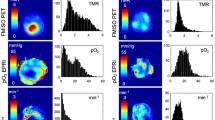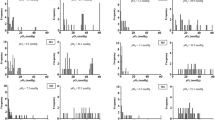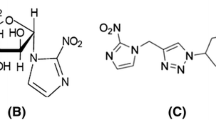Abstract
Purpose
Quantitative evaluation of tumor hypoxia based on H-1-(3-[18F]fluoro-2-hydroxypropyl)-2-nitroimidazole ([18F]FMISO) positron emission tomography (PET) can deliver important information for treatment planning in radiotherapy. However, the merits and limitations of different analysis methods in revealing the underlying physiological feature are not clear. This study aimed to assess these quantitative analysis methods with the support of immunohistological data.
Procedures
Sixteen nude mice bearing xenografted human squamous cell carcinomas (FaDu or CAL-33) were scanned using 2-h dynamic [18F]FMISO PET. Tumors were resected and sliced, and the hypoxia marker pimonidazole was immunostained followed by H&E staining. The pimonidazole signal was segmented using a k-means clustering algorithm, and the hypoxic fraction (HF) was calculated as the hypoxic area/viable tumor-tissue-area ratio pooled over three tissue slices from the apical, center, and basal layers. PET images were analyzed using various methods including static analysis [standard uptake value (SUV), tumor-to-blood ratio (T/B), tumor-to-muscle ratio (T/M)] and kinetic modeling (Casciari αk A , irreversible and reversible two-tissue compartment k 3, Thorwarth w A k 3, Patlak K i , Logan V d , Cho K), and correlated with HF.
Results
No significant correlation was found for static analysis. A significant correlation between k 3 of the irreversible two-tissue compartment model and HF was observed (r = 0.61, p = 0.01). The correlation between HF and αk A of the Casciari model could be improved through reducing local minima by testing more sets of initial values (r = 0.59, p = 0.02) or by reducing the model complexity by fixing three parameters (r = 0.63, p = 0.0008).
Conclusions
With support of immunohistochemistry data, this study shows that various analysis methods for [18F]FMISO PET perform differently for assessment of tumor hypoxia. A better fitting quality does not necessarily mean a higher physiological correlation. Hypoxia PET analysis needs to consider both the mathematical stability and physiological fidelity. Based on the results of this study, preference should be given to the irreversible two-tissue compartment model as well as the Casciari model with reduced parameters.





Similar content being viewed by others
References
Koh WJ, Rasey JS, Evans ML et al (1992) Imaging of hypoxia in human tumors with [18F]Fluoromisonidazole. Int J Radiat Oncol Biol Phys 22:199–212
Rasey JS, Koh WJ, Evans ML et al (1996) Quantifying regional hypoxia in human tumors with positron emission tomography of [18F]Fluoromisonidazole: a pretherapy study of 37 patients. Int J Radiat Oncol Biol Phys 36:417–428
Bruehlmeier M, Roelcke U, Schubiger PA et al (2004) Assessment of hypoxia and perfusion in human brain tumors using PET with [18F]fluoromisonidazole and [15O]H2O. J Nucl Med 45:1851–1859
Eschmann SM, Paulsen F, Reimold M et al (2005) Prognostic impact of hypoxia imaging with [18F]misonidazole PET in non-small cell lung cancer and head and neck cancer before radiotherapy. J Nucl Med 46:253–260
Nehmeh SA, Lee NY, Schroder H et al (2008) Reproducibility of intratumor distribution of [18F]fluoromisonidazole in head and neck cancer. Int J Radiat Oncol Biol Phys 70:235–242
Rajendran JG, Schwartz DL, O’Sullivan J et al (2006) Tumor hypoxia imaging with [18F]fluoromisonidazole positron emission tomography in head and neck cancer. Clin Cancer Res 12:5435–5441
Nordsmark M, Eriksen JG, Gebski V et al (2007) Differential risk assessments from five hypoxia specific assays: the basis for biologically adapted individualized radiotherapy in advanced head and neck cancer patients. Radiother Oncol 83:389–397
Lee NY, Mechalakos JG, Nehmeh S et al (2008) Fluorine-18-labeled fluoromisonidazole positron emission and computed tomography-guided intensity-modulated radiotherapy for head and neck cancer: a feasibility study. Int J Radiat Oncol Biol Phys 70:2–13
Thorwarth D, Eschmann SM, Paulsen F et al (2007) Hypoxia dose painting by numbers: a planning study. Int J Radiat Oncol Biol Phys 68:291–300
Dirix P, Vandecaveye V, De Keyzer F et al (2009) Dose painting in radiotherapy for head and neck squamous cell carcinoma: value of repeated functional imaging with [18F]FDG PET, [18F]fluoromisonidazole PET, diffusion-weighted MRI, and dynamic contrast-enhanced MRI. J Nucl Med 50:1020–1027
Swanson KR, Chakraborty G, Wang CH et al (2009) Complementary but distinct roles for MRI and [18F]fluoromisonidazole PET in the assessment of human glioblastomas. J Nucl Med 50:36–44
Hirata K, Terasaka S, Shiga T et al (2012) [18F]Fluoromisonidazole positron emission tomography may differentiate glioblastoma multiforme from less malignant gliomas. Eur J Nucl Med Mol Imaging 39:760–770
Thorwarth D, Eschmann SM, Paulsen F et al (2005) A kinetic model for dynamic [18F]FMISO PET data to analyse tumour hypoxia. Phys Med Biol 50:2209–2224
Cho H, Ackerstaff E, Carlin S et al (2009) Noninvasive multimodality imaging of the tumor microenvironment: registered dynamic magnetic resonance imaging and positron emission tomography studies of a preclinical tumor model of tumor hypoxia. Neoplasia 11:247–259
Bentzen L, Keiding S, Nordsmark M et al (2003) Tumour oxygenation assessed by [18F]fluoromisonidazole PET and polarographic needle electrodes in human soft tissue tumours. Radiother Oncol 67:339–344
Gunn RN, Gunn SR, Cunningham VJ (2001) Positron emission tomography compartmental models. J Cereb Blood Flow Metab 21:635–652
Huang SC (2008) Role of kinetic modeling in biomedical imaging. J Med Sci 28:57–63
Casciari JJ, Graham MM, Rasey JS (1995) A modeling approach for quantifying tumor hypoxia with [18F]fluoromisonidazole PET time-activity data. Med Phys 22:1127–1139
Wang W, Lee NY, Georgi JC et al (2010) Pharmacokinetic analysis of hypoxia [18F]fluoromisonidazole dynamic PET in head and neck cancer. J Nucl Med 51:37–45
Hong YT, Beech JS, Smith R et al (2011) Parametric mapping of [18F]fluoromisonidazole positron emission tomography using basis functions. J Cereb Blood Flow Metab 31:648–657
Vaupel P, Kallinowski F, Okunieff P (1989) Blood flow, oxygen and nutrient supply, and metabolic microenvironment of human tumors: a review. Cancer Res 49:6449–6465
Eschmann SM, Paulsen F, Bedeshem C et al (2007) Hypoxia-imaging with [18F]misonidazole and PET: changes of kinetics during radiotherapy of head-and-neck cancer. Radiother Oncol 83:406–410
Gagel B, Reinartz P, Dimartino E et al (2004) pO2 polarography versus positron emission tomography ([18F]fluoromisonidazole, [18F]-2-fluoro-2′-deoxyglucose). An appraisal of radiotherapeutically relevant hypoxia. Strahlenther Onkol 180:616–622
Wang W, Georgi JC, Nehmeh SA et al (2009) Evaluation of a compartmental model for estimating tumor hypoxia via FMISO dynamic PET imaging. Phys Med Biol 54:3083–3099
Bartlett RM, Beattie BJ, Naryanan M et al (2012) Image-guided pO2 probe measurements correlated with parametric images derived from [18F]Fluoromisonidazole small-animal PET data in rats. J Nucl Med 53:1608–1615
Choi Y, Huang SC, Hawkins RA et al (1999) Quantification of myocardial blood flow using [13N]ammonia and PET: comparison of tracer models. J Nucl Med 40:1045–1055
Shi K, Souvatzoglou M, Astner ST et al (2010) Quantitative assessment of hypoxia kinetic models by a cross-study of dynamic [18F]FAZA and [15O]H2O in patients with head and neck tumors. J Nucl Med 51:1386–1394
Zimny M, Gagel B, DiMartino E et al (2006) FDG--a marker of tumour hypoxia? A comparison with [18F]fluoromisonidazole and pO2-polarography in metastatic head and neck cancer. Eur J Nucl Med Mol Imaging 33:1426–1431
Bentzen L, Keiding S, Horsman MR et al (2002) Assessment of hypoxia in experimental mice tumours by [18F]fluoromisonidazole PET and pO2 electrode measurements. Influence of tumour volume and carbogen breathing. Acta Oncol 41:304–312
Raleigh JA, Calkins-Adams DP, Rinker LH et al (1998) Hypoxia and vascular endothelial growth factor expression in human squamous cell carcinomas using pimonidazole as a hypoxia marker. Cancer Res 58:3765–3768
Dubois LJ, Lieuwes NG, Janssen MH et al (2011) Preclinical evaluation and validation of [18F]HX4, a promising hypoxia marker for PET imaging. Proc Natl Acad Sci U S A 108:14620–14625
Oehler C, O’Donoghue JA, Russell J et al (2011) [18F]fluromisonidazole PET imaging as a biomarker for the response to 5,6-dimethylxanthenone-4-acetic acid in colorectal xenograft tumors. J Nucl Med 52:437–444
Troost EG, Laverman P, Philippens ME et al (2008) Correlation of [18F]FMISO autoradiography and pimonidazole immunohistochemistry in human head and neck carcinoma xenografts. Eur J Nucl Med Mol Imaging 35:1803–1811
Yaromina A, Thames H, Zhou X et al (2010) Radiobiological hypoxia, histological parameters of tumour microenvironment and local tumour control after fractionated irradiation. Radiother Oncol 96:116–122
Baumann M, Liertz C, Baisch H et al (1994) Impact of overall treatment time of fractionated irradiation on local control of human FaDu squamous cell carcinoma in nude mice. Radiother Oncol 32:137–143
Maftei CA, Shi K, Bayer C et al (2011) Comparison of (immuno-) fluorescence data with serial [18F]FMISO PET/CT imaging for assessment of chronic and acute hypoxia in head and neck cancers. Radiother Oncol 99:412–417
Wong KP, Sha W, Zhang X et al (2011) Effects of administration route, dietary condition, and blood glucose level on kinetics and uptake of [18F]FDG in mice. J Nucl Med 52:800–807
Maftei CA, Bayer C, Shi K et al (2012) Intra- and intertumor heterogeneities in total, chronic, and acute hypoxia in xenografted squamous cell carcinomas: Detection and quantification using (immuno-)fluorescence techniques. Strahlenther Onkol 188:606–615
Dima AA, Elliott JT, Filliben JJ et al (2011) Comparison of segmentation algorithms for fluorescence microscopy images of cells. Cytometry A 79:545–559
Spall JC (2003) Introduction to Stochastic Search and Optimization. John Wiley & Sons Inc, Hoboken, New Jersey
Pogue BW, Paulsen KD, O’Hara JA et al (2001) Estimation of oxygen distribution in RIF-1 tumors by diffusion model-based interpretation of pimonidazole hypoxia and Eppendorf measurements. Radiat Res 155:15–25
Author information
Authors and Affiliations
Corresponding author
Ethics declarations
Conflict of Interest
The authors declare that they have no conflict of interest.
Electronic supplementary material
Below is the link to the electronic supplementary material.
ESM 1
(DOCX 607 kb)
Rights and permissions
About this article
Cite this article
Shi, K., Bayer, C., Astner, S.T. et al. Quantitative Analysis of [18F]FMISO PET for Tumor Hypoxia: Correlation of Modeling Results with Immunohistochemistry. Mol Imaging Biol 19, 120–129 (2017). https://doi.org/10.1007/s11307-016-0975-4
Published:
Issue Date:
DOI: https://doi.org/10.1007/s11307-016-0975-4




